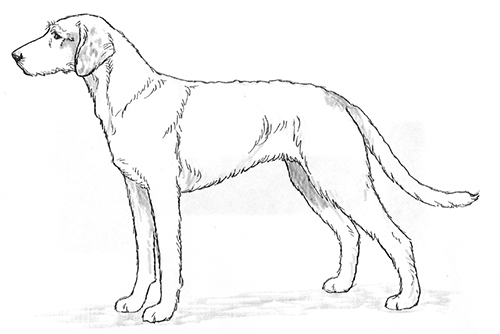Istrian Coarse-Haired Hound
Scenthound Group
The goals and purposes of this breed standard include: to furnish guidelines for breeders who wish to maintain the quality of their breed and to improve it; to advance this breed to a state of similarity throughout the world; and to act as a guide for judges.
Breeders and judges have the responsibility to avoid any conditions or exaggerations that are detrimental to the health, welfare, essence and soundness of this breed, and must take the responsibility to see that these are not perpetuated.
Any departure from the following should be considered a fault, and the seriousness with which the fault should be regarded should be in exact proportion to its degree and its effect upon the health and welfare of the dog and on the dog’s ability to perform its traditional work.
History
The history of the Coarse-Haired Hound in Croatia parallels that of the Smooth-Haired one, though pictorial representations and written descriptions are rare because artists did not favor the tousled outline of the Coarse-Haired breed. They are as equally well suited to fox and hare hunting as their smooth coated cousins.
The Istrian Coarse-Haired Hound was recognized by the United Kennel Club in 2006.
General Appearance
A rough coated, long tailed dog with a snow white ground color and lemon-orange markings.
Characteristics
Gentle, docile, calm and very attached to its owner, the Istrian Coarse-Haired Hound is nevertheless a very enthusiastic hunter.
Head
SKULL
The skull is slightly rounded. The occiput is well developed, and the frontal bone is quite broad. There is a frontal furrow that is often covered by a lock of long hair. The skull narrows in width from the ears to the eyes. The stop is not pronounced.
MUZZLE
The muzzle is strong and rectangular. The bridge is covered by a shaggy mustache. Seen from the front, the lower jaw gives the muzzle a certain roundness.
TEETH
The Istrian Coarse-Haired Hound has a complete set of evenly spaced, white teeth meeting in a scissors bite.
Disqualifications: Undershot or overshot bite.
NOSE
Broad and well developed, with black or dark brown pigment.
EYES
The eyes are large but not bulging. They are dark in color. The expression is serious.
Disqualification: Blue eyes.
EARS
The ears are not very thick. They are covered with shorter hair. They are set on at about the topline of the skull. They widen towards the middle, and are carried close to the cheeks. They should be semi-long, reaching at least to the superciliary arches.
Neck
The neck is arched, with taut skin and no dewlap.
Forequarters
The shoulder blades and upper arms are long and sloping, forming an angle of nearly 90 degrees.
FORELEGS
The legs are upright and well muscled. The pasterns are short and slope no more than 10 percent off the vertical.
Body
The body is approximately 10 percent longer than tall. The chest is broad and well let down, at least to the elbows. The forechest is rounded, with no prominence of the point of the sternum. The ribs are well sprung. The withers are only slightly pronounced, and the topline slopes gently from the withers to the tail. The back is level and broad, and the loin is short and arched. The croup is broad, rounded and slightly sloping.
Hindquarters
HIND LEGS
The upper thigh is short and muscular. The lower thigh is sloping, and is longer than the upper thigh. The hock is broad and strong. The rear pasterns are short and upright.
Feet
Cat feet, but narrow, with tight toes.
Tail
Set not too high, strong at the root and tapering to the end, which reaches to the hock or just below. Carried somewhat low, in saber fashion.
Coat
The outer coat is harsh, fairly long, dull and bristly. It is never curly or wavy. There is a short, thick undercoat which is dependent on climate and season. The length of the outer coat will vary on different parts of the body.
Color
Snow white ground color, with bright lemon-orange markings on the ears and body. The markings must not overwhelm the white ground color.
Disqualification: Any color other than white and lemon-orange.
Height and Weight
Ideal height for males is 20.5 inches at the withers. For females, it is 19.5 inches.
Ideal average weight is about 44 pounds.
Gait
Lively and smooth.
Eliminating Faults
(An Eliminating Fault is a Fault serious enough that it eliminates the dog from obtaining any awards in a conformation event.)
The presence of any third color, even if it is just a few hairs.
More than one inch over or under the heights prescribed in the standard.
Disqualifications
(A dog with a Disqualification must not be considered for placement in a conformation event, and must be reported to UKC.)
Unilateral or bilateral cryptorchid.
Viciousness or extreme shyness.
Albinism.
Undershot or overshot bite.
Blue eyes.
Any color other than white and lemon-orange.

Looking for a Dog?
Find a dog that will fit your family.
Note: The breeders on this list are not endorsed by UKC.
Revised July 1, 2009
©Copyright 2006, United Kennel Club
